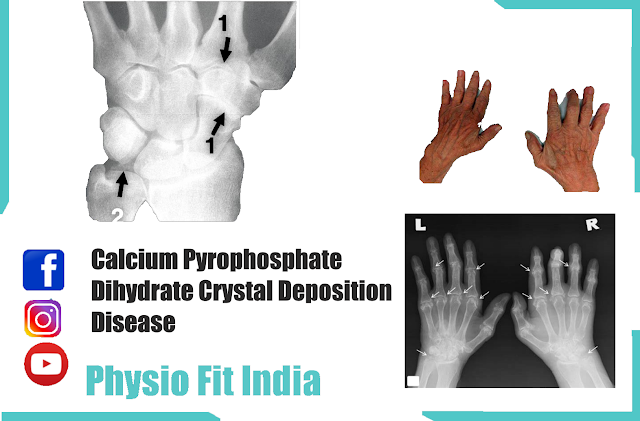Calcium Pyrophosphate Dihydrate Crystal Deposition Disease ➧ it is formation occurs primarily in cartilage. Predisposing factors to crystal formation include aging, familial predisposition, metabolic diseases (hypophosphatasia, hyperparathyroidism, hemochromatosis, Wilson disease, and hypomagnesemia), and osteoarthritis. Crystals may be shed into the joint, causing calcium pyrophosphate dihydrate deposition disease (CPPD). Chondrocalcinosis, pseudogout, and chronic pyrophosphate arthropathy are the three clinical manifestations of CPPD.
Chondrocalcinosis is calcification of fibrocartilage or hyaline cartilage. The incidence of chondrocalcinosis increases with advancing age, and by the ninth decade of life, nearly half of all persons manifest radiographic evidence of joint cartilage calcification; nearly 5% have gross evidence of CPPD at the time of autopsy. Females are affected two to seven times as frequently as males. Fortunately, patients with chondrocalcinosis are frequently asymptomatic.
Pseudogout is the most common cause of acute monoarthritis in the elderly. The acute attack mimics, but is less severe than, gout, with rapid onset of severe joint pain, swelling, and erythema. The knee is involved in more than half of episodes. The wrist is also a common site of involvement, but any joint, including the first metatarsophalangeal joint, may be involved. Acute pseudogout may occur spontaneously or may be associated with an intercurrent illness, trauma, surgery (particularly parathyroidectomy), or thyroxine replacement.
Chronic pyrophosphate arthropathy is more common in females. The knees, wrists, shoulders, elbows, hips, and hands are frequently affected. Symptoms include early morning stiffness, and multiple joints are often involved. Affected joints show swelling and limited motion. Synovitis is typically more severe than with OA but less severe than with RA.
The diagnosis of CPPD can be confirmed by demonstration of the weakly positive, birefringent, rhomboid-shaped calcium pyrophosphate crystals associated with typical symptoms. The synovial fluid white count is usually around 20,000/mm3 .
Acute episodes of pseudogout may be relieved by joint aspiration alone. NSAIDs may also help relieve the acute attack. NSAIDs combined with activity modification, weight reduction, low-impact exercise, and use of canes may be indicated for patients with chronic CPPD symptoms. Most patients do not require surgical reconstructive procedures.




Post a Comment
If you have any doubts any queries so contact me on social media account and send mail